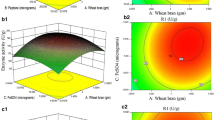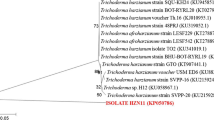Abstract
Cellulases like endoglucanase II (EGII) from Trichoderma reesei are the industrial enzymes responsible for breakdown of cellulosic materials. Due to its importance for production of eco-friendly commercial products such as alternative biofuels, industrial EGII production and optimization of its production conditions merit consideration. The gene responsible for EGII expression was designed and sub-cloned in to pET26b expression vector and transformed into BL21 (DE3) pLysS cells. Protein expression and purification was followed by a RSM design (20 experiments) to optimize the IPTG Concentration, post induction period and cell density (OD600). Thereafter, another RSM design (20 experiments) was performed to find and optimize the most important permeabilizing factors to achieve higher extracellular EGII expression. The EGII expression levels were assessed by Ghose method. The EGII gene was sub-cloned and protein expression and purification were successfully performed. The RSM experiments indicated that 0.331 mM for IPTG Concentration, 10.89 H for post induction period and 3.41 for cell density (OD600) were the optimum culture. Glycine (0.99%), Triton X-100 (0.73%) and CaCl2 (0.232) have been assigned as the most effective membrane permeabalizing factors. Optimization of culture medium components has led to a 3.06 fold increase in extracellular expression of EGII. RSM is an amenable method to optimize the expression of commercially significant enzymes. Our results indicated that optimization of IPTG concentration, post induction period and cell density along with glycine, Triton X-100 and Ca2+ concentration could lead to more cost effective industrial production of EGII.







Similar content being viewed by others
References
Aghaeepoor M, Kobarfard F, Eidgahi MRA, Shabani A, Dehnavi E, Ahmadi M et al (2017) Optimization of culture media for extracellular expression of streptokinase in Escherichia coli using response surface methodology in combination with Plackett–Burman design. Trop J Pharm Res 16:2567–2576
Araujo PW, Brereton RG (1996) Experimental design II. Optimization. TrAC Trends Anal Chem 15:63–70
Baş D, Boyacı İH (2007) Modeling and optimization I: usability of response surface methodology. J Food Eng 78:836–845
Bowden GA, Georgiou G (1990) Folding and aggregation of beta-lactamase in the periplasmic space of Escherichia coli. J Biol Chem 265:16760–16766
Choi JH, Jeong KJ, Kim SC, Lee SY (2000) Efficient secretory production of alkaline phosphatase by high cell density culture of recombinant Escherichia coli using the Bacillus sp. endoxylanase signal sequence. Appl Microbiol Biotechnol 53:640–645
Choi JH, Lee SY (2004) Secretory and extracellular production of recombinant proteins using Escherichia coli. Appl Microbiol Biotechnol 64:625–635
Dutta SG, Shaik AB, Kumar CG, Kamal A (2017) Statistical optimization of production conditions of β-glucosidase from Bacillus stratosphericus strain SG9. 3 Biotech 7(3):221
El-Naggar NA, El-Shweihy NM, El-Ewasy SM (2016) Identification and statistical optimization of fermentation conditions for a newly isolated extracellular cholesterol oxidase-producing Streptomyces cavourensis strain NEAE-42. BMC Microbiol 16:217
Ferreira NL, Margeot A, Blanquet S, Berrin J-G (2014) Use of cellulases from Trichoderma reesei in the twenty-first century—part I: current industrial uses and future applications in the production of second ethanol generation. In: Gupta VK, Schmoll M, Herrera-Estrella A, Upadhyay RS, Druzhinina I, Tuohy M (eds) Biotechnology and biology of Trichoderma. Elsevier, The Netherlands, pp 245–261. https://doi.org/10.1016/B978-0-444-59576-8.00017-5
Foreman PK, Brown D, Dankmeyer L, Dean R, Diener S, Dunn-Coleman NS et al (2003) Transcriptional regulation of biomass-degrading enzymes in the filamentous fungus Trichoderma reesei. J Biol Chem 278:31988–31997
Francis DM, Page R (2010) Strategies to optimize protein expression in E. coli. Curr Protoc Protein Sci 5(24):1–5
Fu XY, Tong WY, Wei DZ (2005) Extracellular production of human parathyroid hormone as a thioredoxin fusion form in Escherichia coli by chemical permeabilization combined with heat treatment. Biotechnol Prog 21:1429–1435
Ghose T (1987) Measurement of cellulase activities. Pure Appl Chem 59:257–268
Hammes W, Schleifer K, Kandler O (1973) Mode of action of glycine on the biosynthesis of peptidoglycan. J Bacteriol 116:1029–1053
Hannig G, Makrides SC (1998) Strategies for optimizing heterologous protein expression in Escherichia coli. Trends Biotechnol 16:54–60
Heikinheimo L, Buchert J, Miettinen-Oinonen A, Suominen P (2000) Treating denim fabrics with Trichoderma reesei cellulases. Text Res J 70:969–973
Horikoshi K, Nakao M, Kurono Y, Sashihara N (1984) Cellulases of an alkalophilic Bacillus strain isolated from soil. Can J Microbiol 30:774–779
Irfan M, Asghar U, Nadeem M, Nelofer R, Syed Q, Shakir HA, Qazi JI (2016) Statistical optimization of saccharification of alkali pretreated wheat straw for bioethanol production. Waste Biomass Valor 7:1389–1396
Juturu V, Wu JC (2014) Microbial cellulases: engineering, production and applications. Renew Sustain Energy Rev 33:188–203
Kaderbhai N, Karim A, Hankey W, Jenkins G, Venning J, Kaderbhai MA (1997) Glycine-inducedextracellular secretion of a recombinant cytochrome expressed in Escherichia coli. Biotechnol Appl Biochem 25:53–61
Kuhad RC, Deswal D, Sharma S, Bhattacharya A, Jain KK, Kaur A et al (2016) Revisiting cellulase production and redefining current strategies based on major challenges. Renew Sustain Energy Rev 55:249–272
Kuhad RC, Gupta R, Singh A (2011) Microbial cellulases and their industrial applications. Enzyme Res. https://doi.org/10.4061/2011/280696
Kumar R, Singh S, Singh OV (2008) Bioconversion of lignocellulosic biomass: biochemical and molecular perspectives. J Ind Microbiol Biotechnol 35:377–391
Larentis AL, Nicolau JF, Esteves Gdos S, Vareschini DT, de Almeida FV, dos Reis MG et al (2014) Evaluation of pre-induction temperature, cell growth at induction and IPTG concentration on the expression of a leptospiral protein in E. coli using shaking flasks and microbioreactor. BMC Res Notes 7:671
Li ZF, Li B, Liu ZG, Wang M, Gu ZB, Du GC et al (2009) Calcium leads to further increase in glycine-enhanced extracellular secretion of recombinant α-cyclodextrin glycosyltransferase in Escherichia coli. J Agric Food Chem 57:6231–6237
Li B, Wang L, Su L, Chen S, Li Z, Chen J et al (2012) Glycine and Triton X-100 enhanced secretion of recombinant α-CGTase mediated by OmpA signal peptide in Escherichia coli. Biotechnol Bioproc Eng 17:1128–1134
Makino T, Skretas G, Georgiou G (2011) Strain engineering for improved expression of recombinant proteins in bacteria. Microb Cell Fact 10:32
Maharjan S, Singh B, Bok J-D, Kim J-I, Jiang T, Cho C-S, Kang S-K, Choi Y-J (2014) Exploring codon optimization and response surface methodology to express biologically active transmembrane RANKL in E. coli. PLoS ONE 9(5):e96259
Medve J, Karlsson J, Lee D, Tjerneld F (1998) Hydrolysis of microcrystalline cellulose by cellobiohydrolase I and endoglucanase II from Trichoderma reesei: adsorption, sugar production pattern, and synergism of the enzymes. Biotechnol Bioeng 59:621–634
Schülein M (1997) Enzymatic properties of cellulases from Humicola insolens. J Biotechnol 57:71–81
Stephanopoulos G (2007) Challenges in engineering microbes for biofuels production. Science 315:801–804
Suominen PL, Mäntylä AL, Karhunen T, Hakola S, Nevalainen H (1993) High frequency one-step gene replacement in Trichoderma reesei. II. Effects of deletions of individual cellulase genes. Mol Gen Genet 241:523–530
Tabssum F, Irfan M, Shakir HA, Qazi JI (2018) RSM based optimization of nutritional conditions for cellulase mediated Saccharification by Bacillus cereus. J Biol Eng 12:7
Waegeman H, Soetaert W (2011) Increasing recombinant protein production in Escherichia coli through metabolic and genetic engineering. J Ind Microbiol Biotechnol 38:1891–1910
Woldringh C (1970) Lysis of the cell membrane of Escherichia coli K12 by ionic detergents. Biochim Biophys Acta (BBA) Nucleic Acids Protein Synth 224:288–90
Yang J, Moyana T, MacKenzie S, Xia Q, Xiang J (1998) One hundred seventy-fold increase in excretion of an FV fragment-tumor necrosis factor alpha fusion protein (sFV/TNF-α) from Escherichia coli caused by the synergistic effects of glycine and Triton X-100. Appl Environ Microbiol 64:2869–2874
Author information
Authors and Affiliations
Corresponding author
Ethics declarations
Conflict of interest
The authors declare that they have no conflict of interest in the publication.
Rights and permissions
About this article
Cite this article
Ghaderi, H., Arasteh, J. & Hesampour, A. Using response surface methodology in combination with Plackett–Burman design for optimization of culture media and extracellular expression of Trichoderma reesei synthetic endoglucanase II in Escherichia coli. Mol Biol Rep 45, 1197–1208 (2018). https://doi.org/10.1007/s11033-018-4272-y
Received:
Accepted:
Published:
Issue Date:
DOI: https://doi.org/10.1007/s11033-018-4272-y




